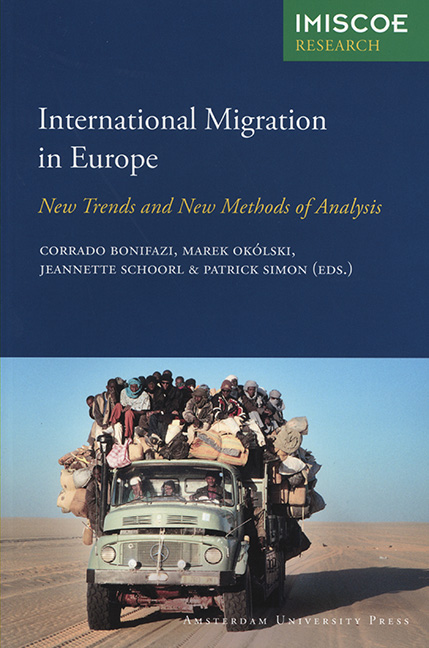Book contents
- Frontmatter
- Contents
- Preface
- 1 Introduction
- PART I NEW FORMS OF MIGRATION IN EUROPE
- PART II EVOLUTION OF REGIONAL PATTERNS OF INTERNATIONAL MIGRATION IN EUROPE
- PART III MEASURING INTEGRATION: IMMIGRANTS AND THE SECOND GENERATION
- PART IV SPECIAL SURVEYS IN INTERNATIONAL MIGRATION STUDIES
- List of Contributors
- Index
- Other IMISCOE Titles
2 - Managing New Migrations in Europe: Concept and Reality in the Ict Sector
Published online by Cambridge University Press: 22 June 2021
- Frontmatter
- Contents
- Preface
- 1 Introduction
- PART I NEW FORMS OF MIGRATION IN EUROPE
- PART II EVOLUTION OF REGIONAL PATTERNS OF INTERNATIONAL MIGRATION IN EUROPE
- PART III MEASURING INTEGRATION: IMMIGRANTS AND THE SECOND GENERATION
- PART IV SPECIAL SURVEYS IN INTERNATIONAL MIGRATION STUDIES
- List of Contributors
- Index
- Other IMISCOE Titles
Summary
The aim of this chapter is twofold. First, it proposes a theoretical framework for explaining migration that takes into account the complexities of the subject and the need to focus on routes of entry. Second, it highlights the role of employers in orchestrating the international mobility of highly skilled labour through the lens of the Information, Communications and Technology (ICT) sector. The ICT sector is new and has developed rapidly over the last fifteen years or so, as has the mobility of staff associated with it. The chapter presents the main findings of an international research project.
Migration, mobility and routes of entry
Any explanation of migration patterns and trends must first get to grips with the complexities of the phenomenon. The last decade or so has seen an explosion of academic, policy and media interest in international migration. Unfortunately, much of that interest has been characterised by a reductionism that has led to oversimplification and misunderstanding, prompting the question: what do we mean by migration?
The answer to this question is by no means straightforward. As indicated above, there is an increasing diversity of flows that challenges traditional notions of ‘migration’. Indeed, it is tempting to suggest that there is no such person as ‘a migrant’, but rather a wide range of people exhibiting different forms of mobility that constitute different types of migration streams. Migration is thus a subcategory of a wider concept of ‘movement’, embracing various types and forms of human mobility from commuting to permanent emigration. What we define as migration is an arbitrary choice about where we draw the line and that may be time-specific. Migration streams are dynamic, involve different types of people and motivations, have different roles and different implications for host and sending societies, and are influenced and managed by different agencies and institutions.
Each of these migration streams has a corresponding ‘route of entry’ into a country, based on the government policies and rules which are designed to regulate entry, allowing governments to fine-tune overall migration flows. In dealing with different scales and types of movement, governments are presented with a range of management challenges.
- Type
- Chapter
- Information
- International Migration in EuropeNew Trends and New Methods of Analysis, pp. 19 - 36Publisher: Amsterdam University PressPrint publication year: 2008



